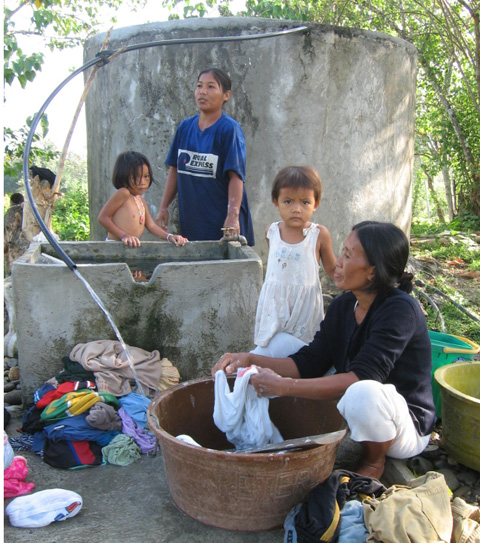Solution of the week 12
Contents
[hide]Hydraulic rams - making water run uphill
Ever seen water flow uphill? Without help of petrol or electricity? Meet the hydraulic ram, a robust and simple water-powered water pump. The ram pumps uses the power of water with a height difference flowing in the spring, stream or river to lift a fraction of the water up to 200 metres vertically, and sometimes pump it over a kilometre or two to where it is needed. No fuel or electricity required. The ram pump holds great potential for rural drinking water and irrigation water supply in hilly and mountainous areas, such as Afghanistan, Colombia, Nepal, and the Philippines.

Hydraulic rams in the Philippines
Many people living in hillside villages in the Philippines do not have easy access to fresh water, and have to make a difficult journey down steep slopes to collect what they require for their basic needs from springs, valley streams or rivers. The water is then carried back in jerry cans on a shoulder yoke. This is dangerous and time-consuming, and means that water is often used only for essential purposes like drinking and cooking, with little spare for hygiene, sanitation or agriculture.
The local NGO Alternative Indigenous Development Foundation Inc. (AIDFI), led by Dutch-born engineer Auke Idzenga, has developed an innovative hydraulic ram pump which can be made locally. It has just two sets of spare parts, both of which are simple and available locally - door hinges and check valves made from used car tires. After some training, the pump can be maintained at community level. In the last ten years, AIDFI has installed 195 of these ram pumps in 128 communities, providing over 38,400 people with access to clean water as well as irrigating large areas of land. The success didn't go unnoticed. In 2007, the AIDFI hydraulic ram pump won the prestigious Ashden Award (presented by Al Gore and Prince Charles), and in 2008 the pump was chosen as one of three nominees out of 800 projects for the European Energy Globe Award.
Benefits to users
Access to water changes lives. Communities in the Philippines go from hardly enough water to drink and cook, to an ample supply of up to 200 - 1000 liters of water per day, per household. As one villager put it: "We used to be so dirty at the end of the day... now we're all clean." Women save significant amounts of time not only by avoiding the trip to collect water, but also because clothes can now be washed in the village, instead of down at the stream. Time saved is now being used to care for children and livestock, and tend vegetable gardens. Sufficient water for irrigation means that vegetable crops can be grown in the dry season and people can keep pigs and poultry and even fish ponds.
Willy Granada, chairman of the Tara Small Farmers Co-op comments: "Look at all my tomatoes! They'd never be here without the pump. And some people have poultry now and they have pigs too. There are so many things you can do if you have water." Central to the success of AIDFI's project has been the involvement of the community in the whole process from installation to on-going maintenance of the ram pumps. This has helped avoid the pitfalls that other ram pump projects encountered which meant that ultimately they were not sustainable.
Akvo projects with Ram Pumps
Akvo has a number of projects with ram pumps in its system. You can support this project on bringing hydraulic ram pumps to upland communities in the Philippines, or this project on transferring hydraulic ram technology to Colombia.
Spreading the word
There is a tremendous need for this kind of technology in many parts of the world. Both AIDFI's approach and the pump design itself, with durable permanent parts and low-cost, easily obtained replacement parts, is ideal for replication, and AIDFI has taken care to document information well, so that other people can understand. AIDFI actively looks for organisations who want to learn how to make the technology, and now provides trainings to people from several countries. AIDFI has already transferred the technology to Afghanistan. Impressive, methinks.
Links
- Website of the Ashden Award, with information on the AIDFI Hydraulic Ram. (Source of the quotes above)
- Website of AIDFI
- Akvopedia article on the Ram pump
- Wikipedia article on the Ram pump
- Video on AIDFI Hydraulic Ram, produced by Ashden Award
- Video on installation of Hydraulic Ram pumps in Afghanistan by AIDFI
- Hydraulic ram pumps by Practical Action
- Ram pumps by the Development Technology Unit, University of Warwick


